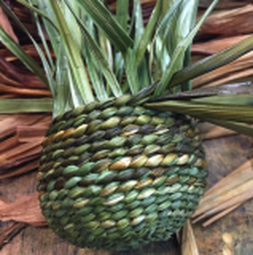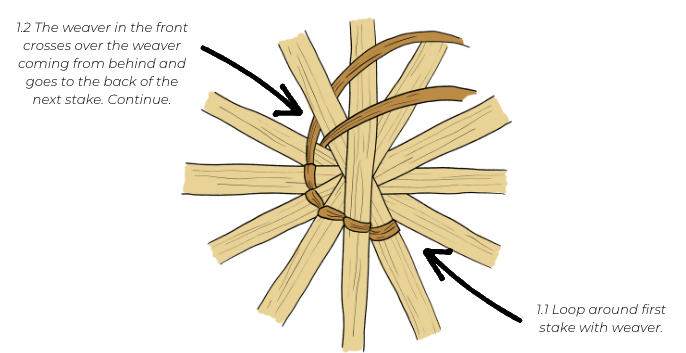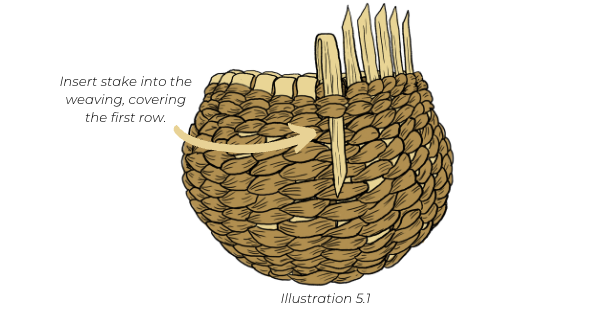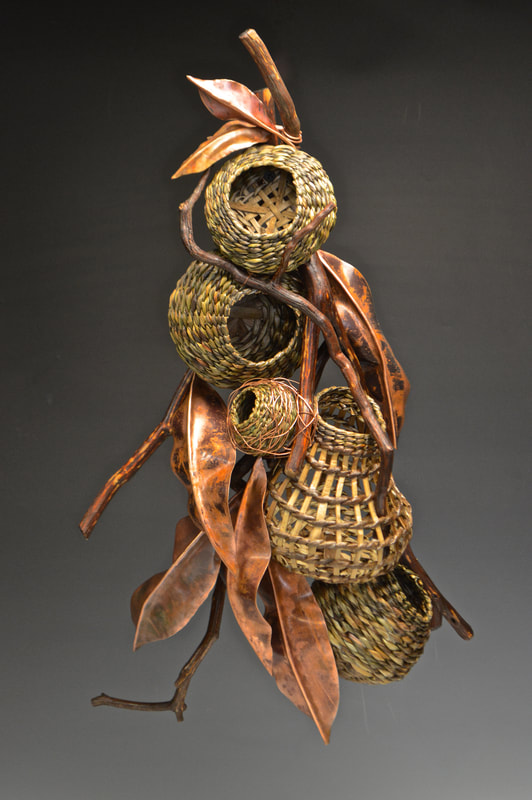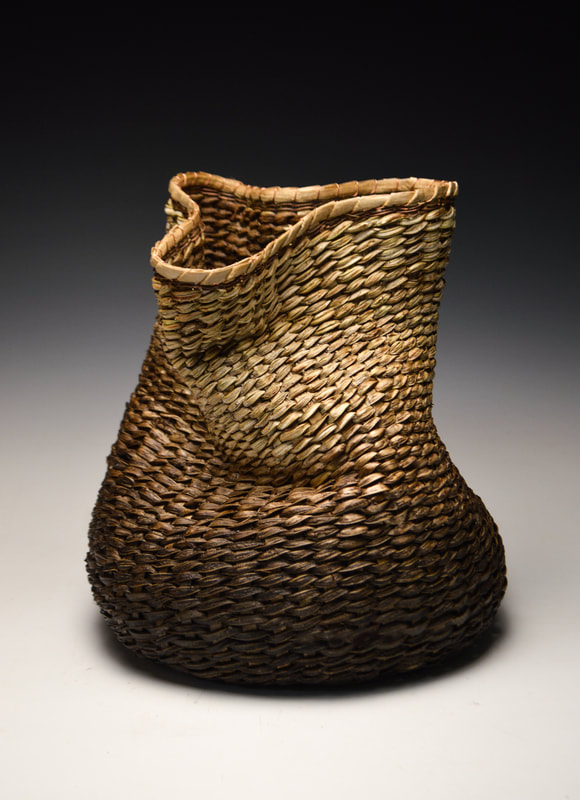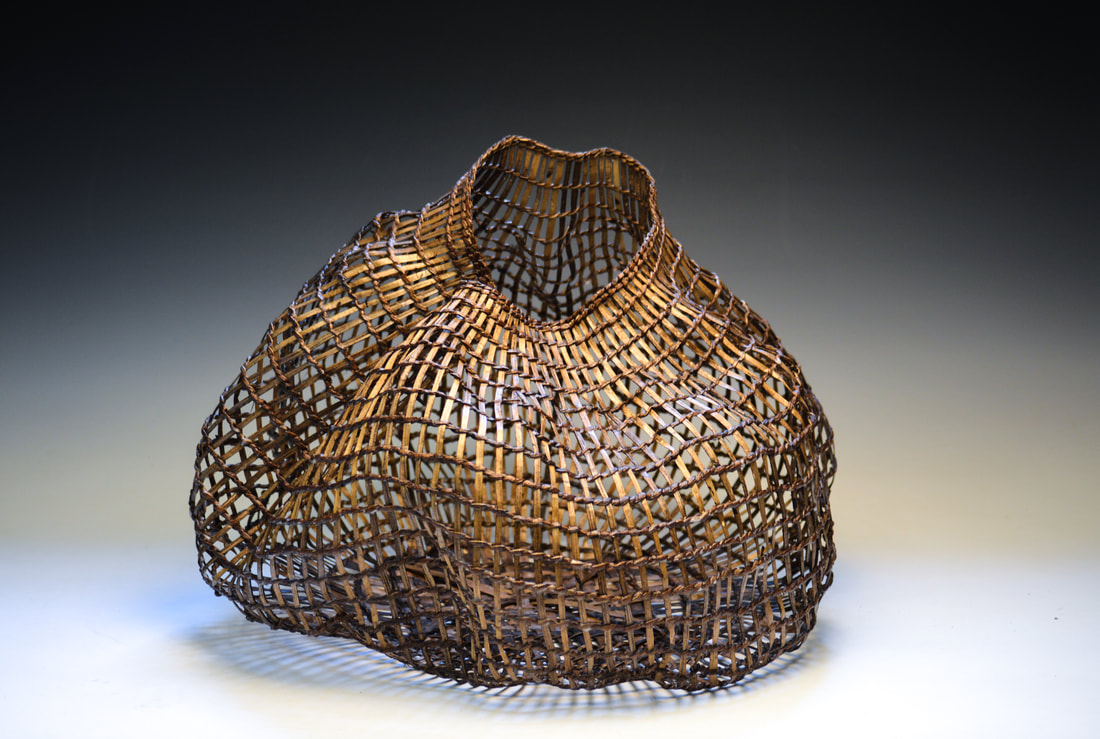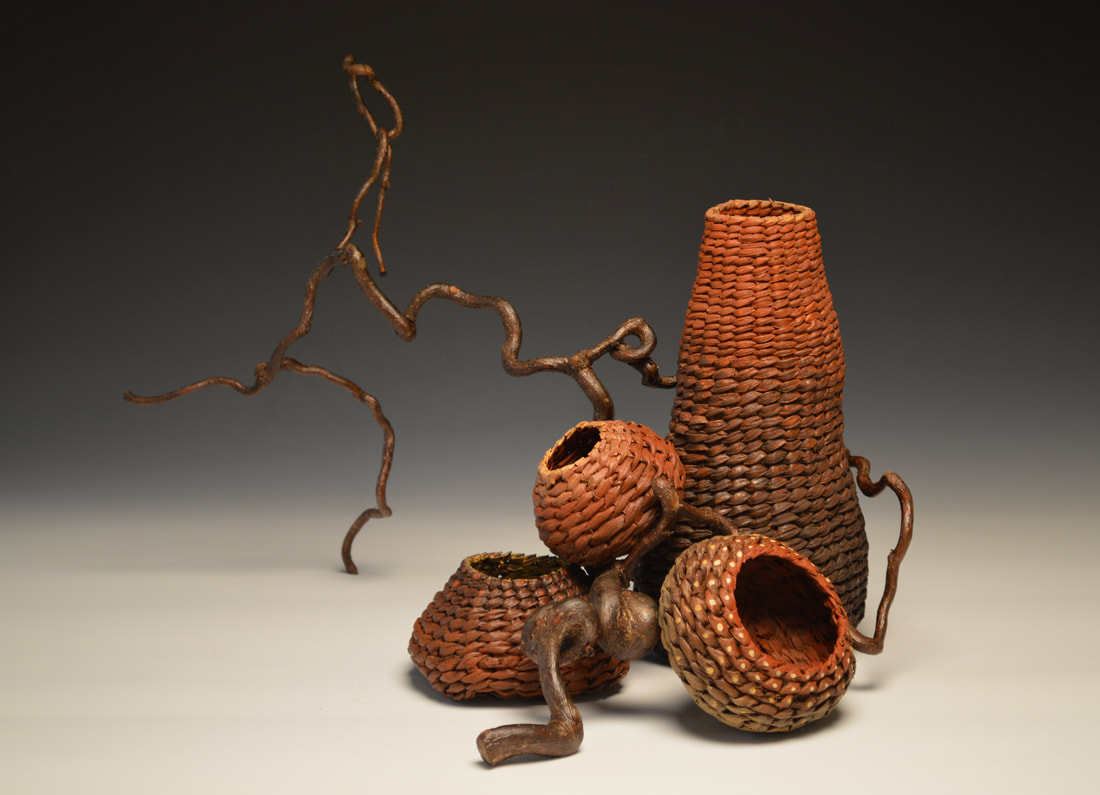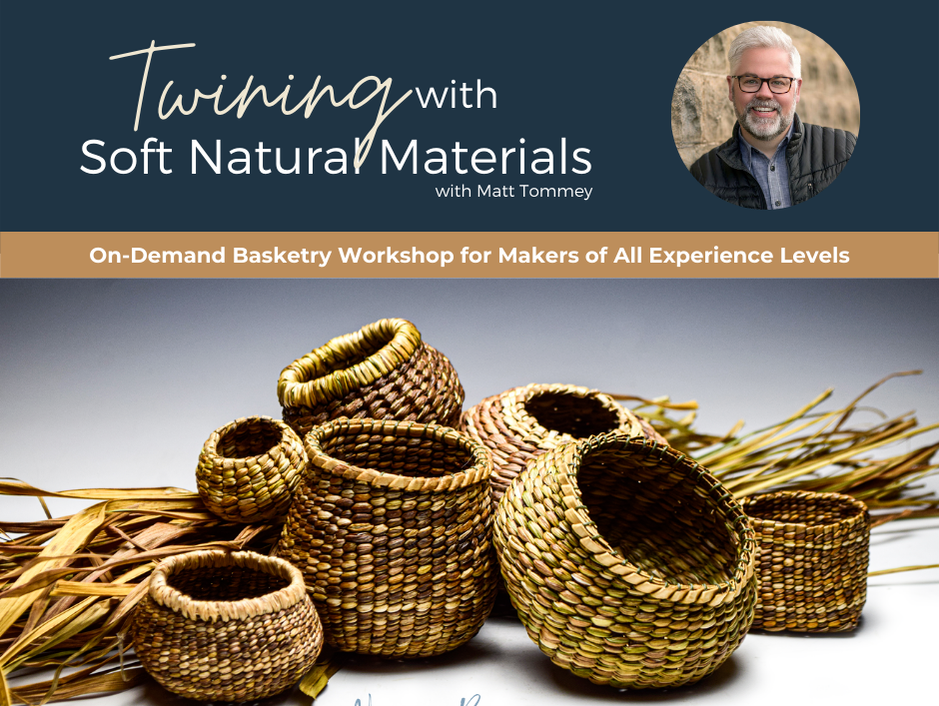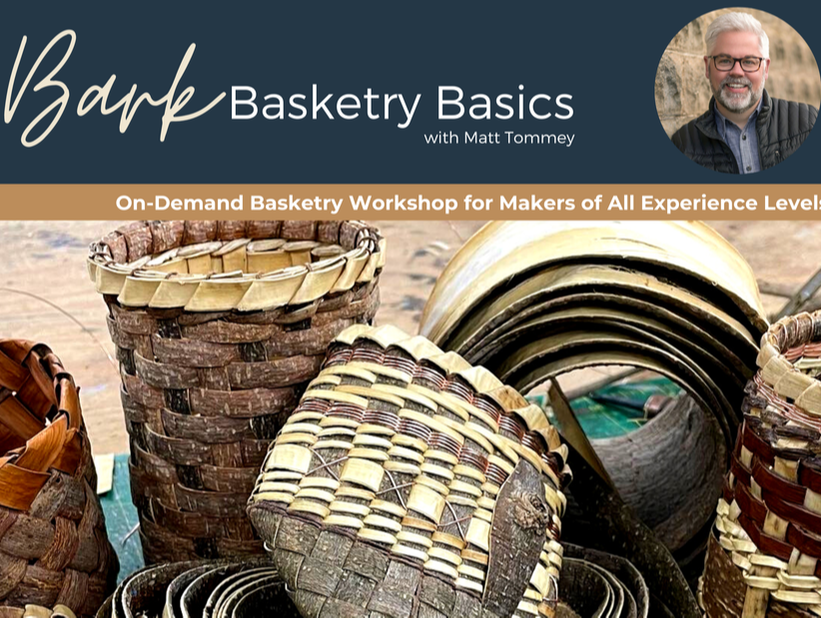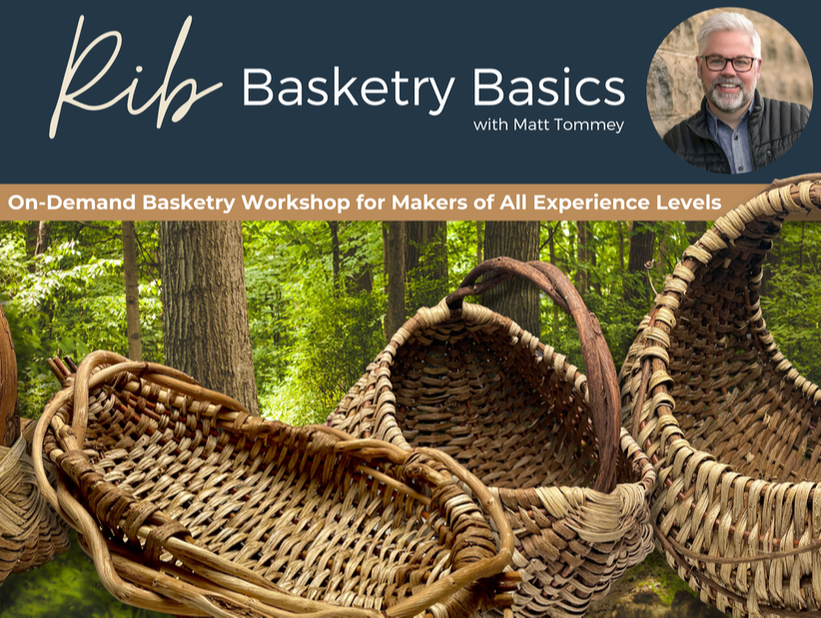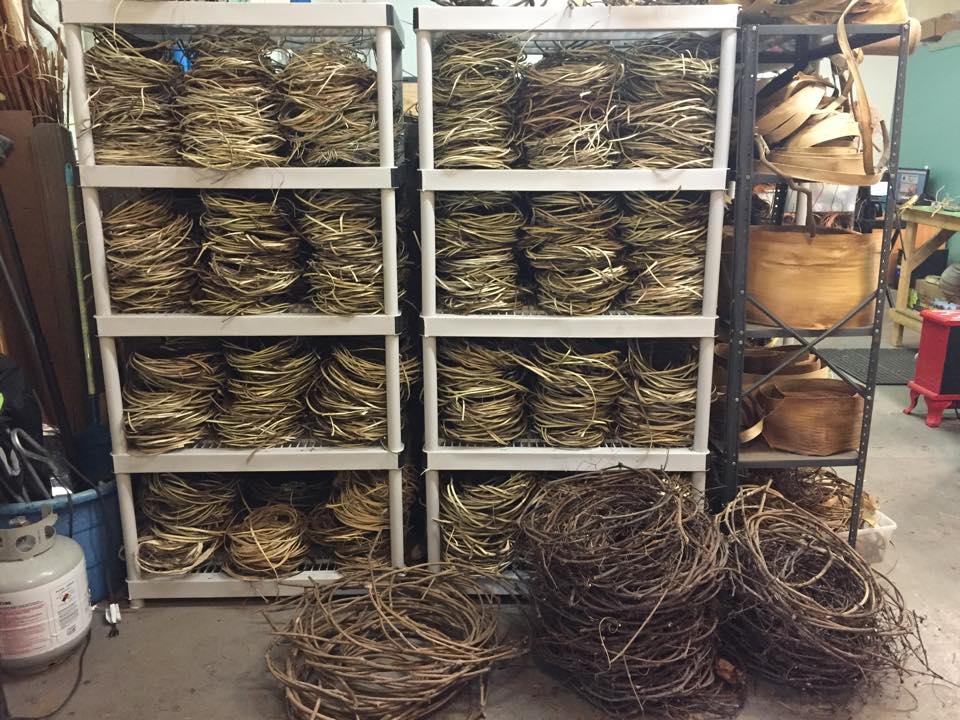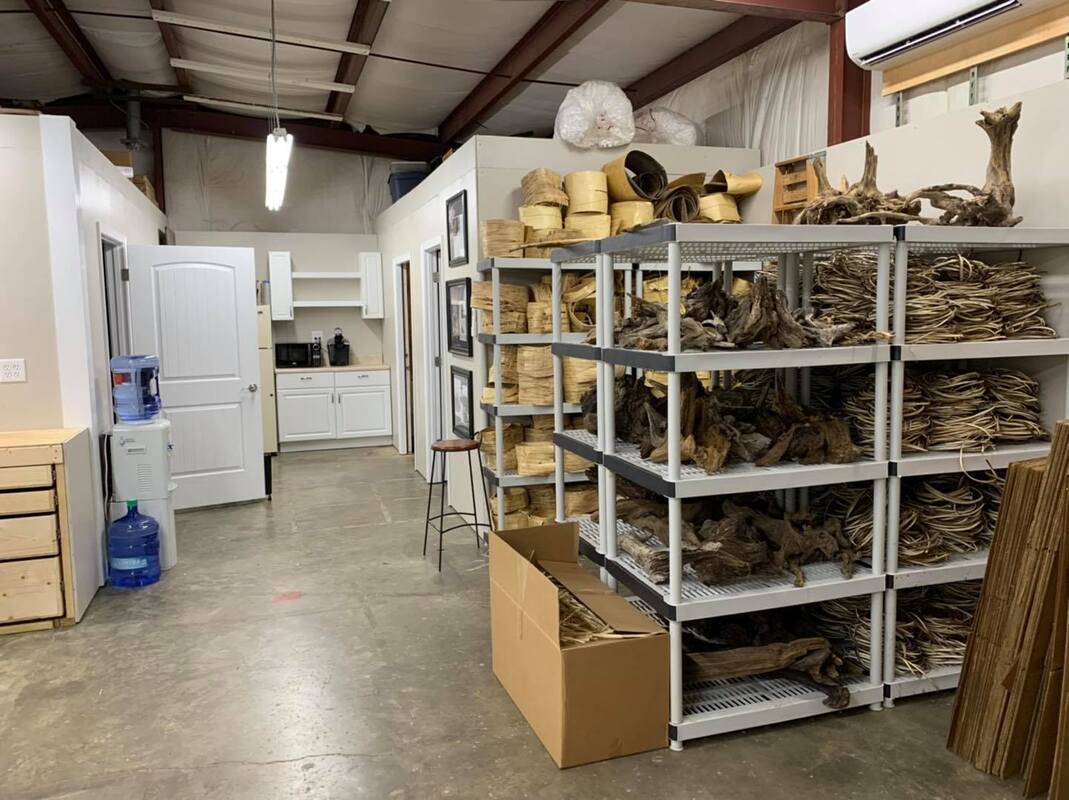IF YOU'RE WONDERING "HOW DO I WEAVE A BASKET" THEN YOU'RE IN THE RIGHT PLACE!
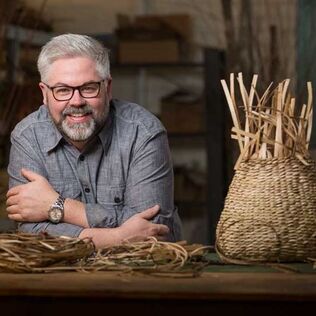 Matt Tommey, Basketry Artist & Teacher
Matt Tommey, Basketry Artist & Teacher
I’m so excited that you want to find out more about making baskets with natural materials. There’s nothing like the joy of walking through the woods, sustainably harvesting materials and creating something beautiful for yourself, a friend or a client.
For over 30 years now, I’ve been creating baskets and woven sculptures from natural materials that I harvest right out of the woods near my homes in Western North Carolina and East Texas. From functional baskets that can be used daily to sculptural art that is displayed in some of the most beautiful homes and commercial spaces in the country, I love creating and teaching! And I can’t wait to share some of the things I’ve learned along the way with you.
One of the things my students know about me is that I love sharing my secrets with them and so I’m doing that with you, too! In this article, I'm going to be giving you some incredible tips on how to weave a basket as well as recommending some deeper study via some additional free articles and my on-demand, online basket weaving courses available 24/7/365 right here on my website. So again, welcome. I'm super glad you're here!
For over 30 years now, I’ve been creating baskets and woven sculptures from natural materials that I harvest right out of the woods near my homes in Western North Carolina and East Texas. From functional baskets that can be used daily to sculptural art that is displayed in some of the most beautiful homes and commercial spaces in the country, I love creating and teaching! And I can’t wait to share some of the things I’ve learned along the way with you.
One of the things my students know about me is that I love sharing my secrets with them and so I’m doing that with you, too! In this article, I'm going to be giving you some incredible tips on how to weave a basket as well as recommending some deeper study via some additional free articles and my on-demand, online basket weaving courses available 24/7/365 right here on my website. So again, welcome. I'm super glad you're here!
A SIMPLE BASKET WEAVING TUTORIAL FOR BEGINNERS USING NATURAL MATERIALS
|
Twining is a basic basketry technique that's been used for many thousands of years in just about every society around the globe. It's simplicity, durability and beauty continue to make it a favorite of basketmakers.
Although there are many variations of twining, the basic version goes like this (using a spiral base as an example): |
Step 1: Hold the base securely with your left hand (non-dominant) with your right hand (dominant weaving hand), loop a single weaver around the first stake, (See Illustration above) making one end longer than the other. The short end only needs to be about 8-10" long at this point.
Step 2: Now you have two weavers. (See Illustration 1.2) The weaver in front should cross over the weaver coming from behind and proceed behind the next stake, allowing the weaver from behind to now be in front of that same stake.
Step 3: Repeat this pattern - the one that's in the front crosses over the weaver coming from the back and goes behind the next stake. Each time you create a stitch, firmly pull each weaver with your right hand while simultaneously pulling up on the stake with your left hand. This will ensure a tight, uniform and smooth weave. NOTE: In general, the bigger the basket, the more movement you'll get in the basket like in my more organic. Also, fine weavers and stakes help, too!
Simple Cut & Tuck Rim
The Cut & Tuck Rim is a simple way to finish off a basket that doesn't need a decorative rim. It securely finishes the basket and gives a nice clean finish. It can also be used as a base for other more decorative rims, such as the wrapped rim.
Step 2: Now you have two weavers. (See Illustration 1.2) The weaver in front should cross over the weaver coming from behind and proceed behind the next stake, allowing the weaver from behind to now be in front of that same stake.
Step 3: Repeat this pattern - the one that's in the front crosses over the weaver coming from the back and goes behind the next stake. Each time you create a stitch, firmly pull each weaver with your right hand while simultaneously pulling up on the stake with your left hand. This will ensure a tight, uniform and smooth weave. NOTE: In general, the bigger the basket, the more movement you'll get in the basket like in my more organic. Also, fine weavers and stakes help, too!
Simple Cut & Tuck Rim
The Cut & Tuck Rim is a simple way to finish off a basket that doesn't need a decorative rim. It securely finishes the basket and gives a nice clean finish. It can also be used as a base for other more decorative rims, such as the wrapped rim.
Step 1: Once you have completed all weaving, pack and then trim remaining stakes to a length of 2" long.
Step 2: Cut the tip of each exposed stake at a sharp diagonal angle.
Step 3: Count down three rows of twining from the top of the weaving. Insert your awl into rows 2 and 3, opening up a space.
Step 4: While leaving the awl inserted under the twining, take the exposed stake and fold it over the outside of the basket, preparing to insert it under the two rows of twining. You will be covering one row of twining (See Illustration 5.1).
Step 5: Remove the awl and quickly insert the angled end of the stake under the twining. Gently pull to secure. You may leave the end as a decorative element or trim to your desired length. I prefer to trim even with the twining so the stake is unseen.
NOTE: You may also do this inside the basket. When you do, you'll still be covering one row of twining, but it won't be seen from the outside of the basket.
Step 2: Cut the tip of each exposed stake at a sharp diagonal angle.
Step 3: Count down three rows of twining from the top of the weaving. Insert your awl into rows 2 and 3, opening up a space.
Step 4: While leaving the awl inserted under the twining, take the exposed stake and fold it over the outside of the basket, preparing to insert it under the two rows of twining. You will be covering one row of twining (See Illustration 5.1).
Step 5: Remove the awl and quickly insert the angled end of the stake under the twining. Gently pull to secure. You may leave the end as a decorative element or trim to your desired length. I prefer to trim even with the twining so the stake is unseen.
NOTE: You may also do this inside the basket. When you do, you'll still be covering one row of twining, but it won't be seen from the outside of the basket.
EXAMPLES OF WHAT YOU CAN CREATE USING TWINING
ONLINE BASKET WEAVING CLASSES
I've taught thousands of people how to weave baskets over the years with natural materials. And now, through the power of technology, I've transferred that knowledge to even more students through my online basket weaving courses. Each course is a full-length, up-close-and-personal tutorial from me filmed in my studio as I walk the viewer through how to make a basket using various techniques like twining, rib work, plain weaving, plaiting, random weave and more.
If you love the baskets above and want to learn about twining, check out the Twining with Soft Natural Materials course, below.
If you love the baskets above and want to learn about twining, check out the Twining with Soft Natural Materials course, below.
NATURAL MATERIALS FOR BASKET WEAVING
Depending on where you live, you probably have a large variety of materials that could be used for basket weaving. Grasses and sedges, invasive vines, foliage from the garden, bark and much more could be right at your fingertips. While not a comprehensive list, here’s a list of some of my favorite materials to harvest that many people use for basketry.
|
Vines:
Woody Twigs & Stems
|
Bark:
|
Foliage & Grasses:
Roots:
|
MORE ABOUT MATERIALS FOR BASKET WEAVING
Basket weaving materials encompass a diverse range of natural and recycled elements, each offering unique properties that influence the final look, durability, and functionality of the basket. Understanding these materials is paramount for weavers aiming for successful and meaningful creations.
Natural Materials
Recycled Materials
Understanding Material Characteristics
The properties of each material significantly impact the weaving process and the final outcome of the basket. Factors like flexibility, strength, color, and texture influence the weaving technique, design possibilities, and the intended use of the basket.
For instance, a functional basket intended for heavy-duty use might require a sturdy and resilient material like willow or rattan. Conversely, a sculptural piece focusing on intricate designs might benefit from more flexible materials like vines or softer reeds.
Sourcing Materials
Weavers can find materials through specialty craft stores, online suppliers, or by gathering natural materials from their surroundings. Local farms, garden centers, or even recycling centers might offer a variety of materials ripe for weaving.
Gathering natural materials requires knowledge of seasonal availability, ethical harvesting techniques, and proper preparation methods, such as drying or soaking, to ensure optimal weaving conditions.
The world of basket weaving materials is rich and diverse, offering endless possibilities for creativity and expression. Weavers must not only select materials based on aesthetics but also consider their inherent properties to ensure successful and fulfilling weaving experiences. Embracing the uniqueness of each material allows for a deeper understanding of the craft and the creation of baskets that are both functional and artistically compelling.
Natural Materials
- Reeds and Grasses
Reeds and grasses are among the most commonly used materials in basket weaving. Ranging from sturdy to flexible, materials like rattan, willow, cane, and bamboo provide diverse weaving options. Willow, for instance, is prized for its flexibility, making it ideal for intricate weaves, while bamboo offers strength and durability suitable for functional baskets.
These materials are often sourced from specialized suppliers or can be gathered directly from nature, provided ethical harvesting practices are observed. Many weavers prefer to harvest their own materials, ensuring sustainability and a deeper connection to the craft. - Vines
Vines, such as wisteria, honeysuckle, or grapevine, offer a different weaving experience. They tend to be more flexible, allowing for intricate weaving patterns and organic shapes. However, vines often require soaking or manipulation to achieve the desired pliability before weaving. - Bark
Many barks are wonderful for weaving when properly prepared. Both the inner and outer bark of many trees can be used. Thinner bark trees like mimosa are great for weaving whole. Other thicker barks like elm, willow, poplar and hickory can be split and thinned for use.
Recycled Materials
- Newspaper, Fabric Strips, and Plastic
Recycled materials have gained popularity in basket weaving, offering environmentally friendly alternatives. Newspaper, when twisted or rolled, mimics the texture and strength of traditional materials. Similarly, fabric strips from old clothing or discarded textiles can be braided or woven to create colorful and unique baskets. Plastic materials, like discarded grocery bags or plastic straws, can be repurposed creatively. They require heat treatment or manipulation to ensure flexibility and cohesion but offer durability and an opportunity to reduce waste. Metal wire and straps like copper and aluminum are wonderful weaving materials, too.
Understanding Material Characteristics
The properties of each material significantly impact the weaving process and the final outcome of the basket. Factors like flexibility, strength, color, and texture influence the weaving technique, design possibilities, and the intended use of the basket.
For instance, a functional basket intended for heavy-duty use might require a sturdy and resilient material like willow or rattan. Conversely, a sculptural piece focusing on intricate designs might benefit from more flexible materials like vines or softer reeds.
Sourcing Materials
Weavers can find materials through specialty craft stores, online suppliers, or by gathering natural materials from their surroundings. Local farms, garden centers, or even recycling centers might offer a variety of materials ripe for weaving.
Gathering natural materials requires knowledge of seasonal availability, ethical harvesting techniques, and proper preparation methods, such as drying or soaking, to ensure optimal weaving conditions.
The world of basket weaving materials is rich and diverse, offering endless possibilities for creativity and expression. Weavers must not only select materials based on aesthetics but also consider their inherent properties to ensure successful and fulfilling weaving experiences. Embracing the uniqueness of each material allows for a deeper understanding of the craft and the creation of baskets that are both functional and artistically compelling.
7 BIGGEST MISTAKES PEOPLE MAKE WHEN TRYING TO WEAVE A BASKET WITH NATURAL MATERIALS
- Harvesting at the wrong time of year
Vines & Twigs: These are best harvested during the wintertime when the sap is down and the plant is at its strongest. Also, it’s when the foliage has fallen off which makes the vines or twigs much easier to see and harvest. Foliage: Most foliage from the garden can be harvested when green but after the plant has flowered. Daylily, daffodil and iris are common plants found in many residential gardens. The fresh green foliage can be cut and dried or you can harvest the foliage that has died and shriveled at the bottom of the plant. Bark: All bark should be harvested in the late spring to early summer time when the sap is running high in the tree. Otherwise, the bark will not separate from the wood, making it impossible to remove. - Incorrect Tools
Having the right tools makes all the difference. Most of the time when I’m harvesting, I am using my favorite locking blade pocket knife and a good pair of handheld garden secateurs. For bigger jobs like harvesting bark, I use loppers, hand saws and chainsaws. Don’t use any tool without understanding and following all the safety guidelines. It can be the difference between life and death. Always make sure your knives, clippers, saws and blades are sharp and clean before each use. Dull, dirty tools often result in frustration and even injury. Cleaning and sharpening before use is always a good idea. - Unsustainbly Sourcing Natural Materials
It’s vitally important to remember that you should harvest all natural materials in a sustainable and respectful manner from locations where you have permission from the landowner or governmental authorities. Take only the materials that you can use within a reasonable amount of time. Respect the natural world while in the forest and leave enough source materials for next time. - Not Drying Materials before Use
Most basketry materials should be harvested and dried before using. This allows the material to shrink prior to being woven. It’s also one of the secrets to having tight baskets! Dry your material as quickly as possible. When the weather is hot, drying outside is ideal. If weather doesn’t permit, then drying in a temperature controlled environment will work just as well. How long does it take? Until it’s dry. - Not Protecting Materials from Moisture
Moisture is the enemy of natural materials because it can easily lead to mold damage and ultimately, rot. Always store your completely dried materials in a cool, dry space. I prefer to store my materials in a temperature controlled environment on open shelving in order to promote airflow. NEVER store materials in plastic bins as moisture will collect and cause mold. - Not Preserving Materials from Bug Infestation
All natural materials harvested from nature are prone to insect infestation if not treated with some sort of repellant. Over the years, I’ve tried a lot of products, but the one I rely on most is called Boracare. This non-toxic concentrate can be mixed with warm water and applied with a garden spray bottle according to the directions. It’s made in the USA and available on Amazon.com.
Functional vs Sculptural Basketry
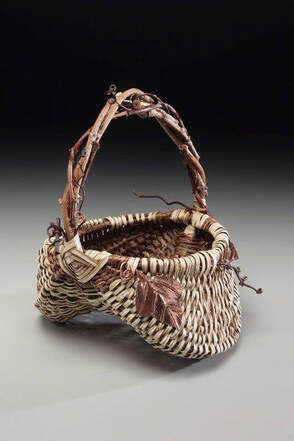 Traditional Egg Basket made from kudzu and grapevine by basketry artist, Matt Tommey
Traditional Egg Basket made from kudzu and grapevine by basketry artist, Matt Tommey
Functional and sculptural baskets stand as distinct expressions within the art of basket weaving, diverging in purpose, design, and utility. Understanding their differences illuminates the unique craftsmanship behind each type.
Functional Baskets: Beauty in Utility
Functional baskets are crafted with a primary focus on practicality and utilitarian purposes. They serve as vessels for carrying, storing, or organizing items, reflecting the weaver's skill in creating objects of both functionality and aesthetic appeal.
Purpose-Driven Design
The design of functional baskets revolves around meeting specific needs. They are engineered to hold specific items, withstand use, and often follow traditional patterns and structures that have evolved to serve practical functions. For instance, a market basket might feature a wide opening for easy access and sturdy handles for carrying heavy loads.
Materials and Construction
Materials chosen for functional baskets prioritize durability and strength. Weavers often employ sturdier and more resilient materials, such as sturdy reeds, thicker grasses, or even synthetic materials, to ensure the basket's longevity and ability to withstand wear and tear.
Aesthetic Elements
While functionality takes precedence, aesthetic elements are not overlooked. Functional baskets often exhibit simple yet elegant designs, incorporating basic weaving techniques that add beauty without compromising utility. Patterns and colors might be subtle, complementing the basket's functionality.
Functional Baskets: Beauty in Utility
Functional baskets are crafted with a primary focus on practicality and utilitarian purposes. They serve as vessels for carrying, storing, or organizing items, reflecting the weaver's skill in creating objects of both functionality and aesthetic appeal.
Purpose-Driven Design
The design of functional baskets revolves around meeting specific needs. They are engineered to hold specific items, withstand use, and often follow traditional patterns and structures that have evolved to serve practical functions. For instance, a market basket might feature a wide opening for easy access and sturdy handles for carrying heavy loads.
Materials and Construction
Materials chosen for functional baskets prioritize durability and strength. Weavers often employ sturdier and more resilient materials, such as sturdy reeds, thicker grasses, or even synthetic materials, to ensure the basket's longevity and ability to withstand wear and tear.
Aesthetic Elements
While functionality takes precedence, aesthetic elements are not overlooked. Functional baskets often exhibit simple yet elegant designs, incorporating basic weaving techniques that add beauty without compromising utility. Patterns and colors might be subtle, complementing the basket's functionality.
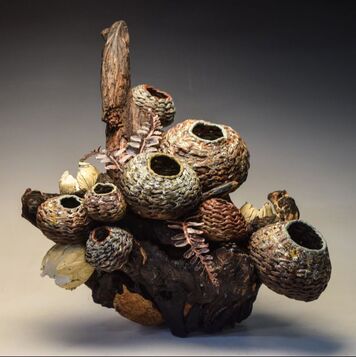 Woven organic sculpture by basketry artist, Matt Tommey
Woven organic sculpture by basketry artist, Matt Tommey
Sculptural Baskets: Artistry and Expression
Sculptural baskets, on the other hand, are creations celebrated primarily for their artistic value. They transcend practicality and serve as artistic expressions, blurring the lines between traditional craft and fine art.
Artistic Freedom
The creation of sculptural baskets allows weavers the freedom to experiment with unconventional shapes, intricate designs, and innovative techniques. These baskets often push the boundaries of traditional basketry, exploring forms that challenge perception and provoke thought.
Emphasis on Aesthetics
Unlike functional baskets, where utility dictates design, sculptural baskets prioritize aesthetics. They might feature intricate weaving patterns, unconventional materials, or experimental forms intended to evoke emotions or convey a narrative, showcasing the weaver's artistic prowess.
Display and Collection
Sculptural baskets are crafted with the intent of being displayed as art pieces rather than serving practical purposes. They find their place in galleries, exhibitions, and collections, inviting appreciation for the craftsmanship and artistic vision they embody.
Bridging the Divide
While functional and sculptural baskets differ in purpose and intent, they often intersect, with some baskets blurring the lines between the two realms. Talented weavers might infuse functional baskets with artistic elements, creating pieces that marry utility with artistic expression.
In essence, the distinction between functional and sculptural baskets lies in their primary intent—utility versus artistic expression. Yet, both celebrate the age-old craft of basket weaving, showcasing the diversity and creativity within this ancient art form.
Sculptural baskets, on the other hand, are creations celebrated primarily for their artistic value. They transcend practicality and serve as artistic expressions, blurring the lines between traditional craft and fine art.
Artistic Freedom
The creation of sculptural baskets allows weavers the freedom to experiment with unconventional shapes, intricate designs, and innovative techniques. These baskets often push the boundaries of traditional basketry, exploring forms that challenge perception and provoke thought.
Emphasis on Aesthetics
Unlike functional baskets, where utility dictates design, sculptural baskets prioritize aesthetics. They might feature intricate weaving patterns, unconventional materials, or experimental forms intended to evoke emotions or convey a narrative, showcasing the weaver's artistic prowess.
Display and Collection
Sculptural baskets are crafted with the intent of being displayed as art pieces rather than serving practical purposes. They find their place in galleries, exhibitions, and collections, inviting appreciation for the craftsmanship and artistic vision they embody.
Bridging the Divide
While functional and sculptural baskets differ in purpose and intent, they often intersect, with some baskets blurring the lines between the two realms. Talented weavers might infuse functional baskets with artistic elements, creating pieces that marry utility with artistic expression.
In essence, the distinction between functional and sculptural baskets lies in their primary intent—utility versus artistic expression. Yet, both celebrate the age-old craft of basket weaving, showcasing the diversity and creativity within this ancient art form.
CREATING YOUR OWN BASKET WEAVING STUDIO
Creating a conducive and inspiring workspace for basket weaving doesn't necessarily require a dedicated studio. With thoughtful planning and organization, any corner of your home can transform into a comfortable and inspirational weaving space.
Assessing Space and Accessibility
Choose a Suitable AreaLook for a well-lit area with ample space where you can comfortably work. It could be a corner in a room, a nook by a window, or even a section of your living room.
Accessibility to Materials and Tools
Ensure easy access to your basket weaving materials, tools, and supplies. Organize them in containers or shelves nearby, allowing for quick and convenient reach during weaving sessions.
Water & Heating Source
Guaranteed, if you're working with most basket weaving material - especially natural materials for basket weaving - you'll need easy access to water and a heat source to heat your water to a boil.
Ergonomics and Comfort
Seating and Work SurfaceSelect a comfortable chair or stool that provides adequate support for long hours of weaving. Pair it with a sturdy and appropriately sized work surface, like a table or a lap board, at a comfortable height for weaving.
Lighting
Natural light is ideal, but if it's limited, supplement it with task lighting. Position a lamp or adjustable light source to illuminate your workspace without causing glare on your weaving materials.
Organization and Storage
Storage SolutionsUse baskets, bins, or shelves to organize your materials and tools. Label containers to easily identify and access specific items, keeping your workspace tidy and clutter-free.
Portable Storage
Consider portable storage solutions if your weaving space is temporary or shared. Caddies or rolling carts can keep your materials organized and easily movable when needed.
Personal Touch and Inspiration
Inspiration Board or DisplayCreate an inspiration board or hang finished baskets to motivate and inspire your weaving journey. Displaying your work-in-progress or favorite designs can boost creativity and serve as a visual reference.
Personalization
Infuse your space with elements that reflect your style and personality. Add plants, artwork, or decorative touches to make the space inviting and enjoyable.
Flexibility and Adaptability
Foldable or Collapsible FurnitureIf space is limited, opt for foldable or collapsible furniture that can be easily stored when not in use, maximizing the available space for other activities.
Mobile Workstation
Consider a portable weaving setup if you need flexibility. A lap loom or smaller weaving tools can allow you to weave comfortably in different areas of your home.
Creating a comfortable and inspiring workspace for basket weaving doesn't require a dedicated studio. By maximizing available space, prioritizing organization and comfort, and infusing personal touches, you can transform any area of your home into a welcoming weaving haven. The key lies in adaptability, organization, and making the space uniquely yours to foster creativity and enjoyment in your basket weaving pursuits.
Assessing Space and Accessibility
Choose a Suitable AreaLook for a well-lit area with ample space where you can comfortably work. It could be a corner in a room, a nook by a window, or even a section of your living room.
Accessibility to Materials and Tools
Ensure easy access to your basket weaving materials, tools, and supplies. Organize them in containers or shelves nearby, allowing for quick and convenient reach during weaving sessions.
Water & Heating Source
Guaranteed, if you're working with most basket weaving material - especially natural materials for basket weaving - you'll need easy access to water and a heat source to heat your water to a boil.
Ergonomics and Comfort
Seating and Work SurfaceSelect a comfortable chair or stool that provides adequate support for long hours of weaving. Pair it with a sturdy and appropriately sized work surface, like a table or a lap board, at a comfortable height for weaving.
Lighting
Natural light is ideal, but if it's limited, supplement it with task lighting. Position a lamp or adjustable light source to illuminate your workspace without causing glare on your weaving materials.
Organization and Storage
Storage SolutionsUse baskets, bins, or shelves to organize your materials and tools. Label containers to easily identify and access specific items, keeping your workspace tidy and clutter-free.
Portable Storage
Consider portable storage solutions if your weaving space is temporary or shared. Caddies or rolling carts can keep your materials organized and easily movable when needed.
Personal Touch and Inspiration
Inspiration Board or DisplayCreate an inspiration board or hang finished baskets to motivate and inspire your weaving journey. Displaying your work-in-progress or favorite designs can boost creativity and serve as a visual reference.
Personalization
Infuse your space with elements that reflect your style and personality. Add plants, artwork, or decorative touches to make the space inviting and enjoyable.
Flexibility and Adaptability
Foldable or Collapsible FurnitureIf space is limited, opt for foldable or collapsible furniture that can be easily stored when not in use, maximizing the available space for other activities.
Mobile Workstation
Consider a portable weaving setup if you need flexibility. A lap loom or smaller weaving tools can allow you to weave comfortably in different areas of your home.
Creating a comfortable and inspiring workspace for basket weaving doesn't require a dedicated studio. By maximizing available space, prioritizing organization and comfort, and infusing personal touches, you can transform any area of your home into a welcoming weaving haven. The key lies in adaptability, organization, and making the space uniquely yours to foster creativity and enjoyment in your basket weaving pursuits.
Copyright 2023 Matt Tommey | Tommey Capital LLC . All rights reserved.
Mailing Address: PO Box 1382 Lindale, Texas 75771
Studio Address:Private By Appointment Only
(404) 538-5173.
Mailing Address: PO Box 1382 Lindale, Texas 75771
Studio Address:Private By Appointment Only
(404) 538-5173.

